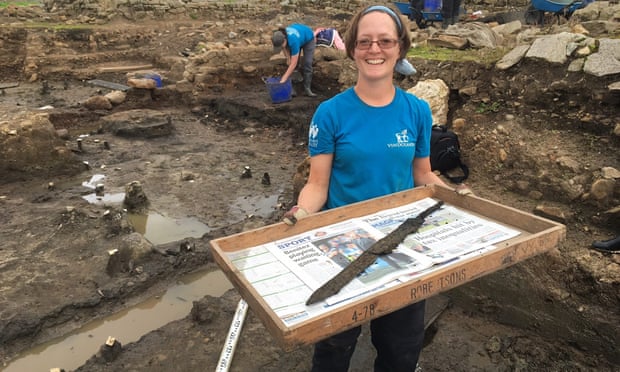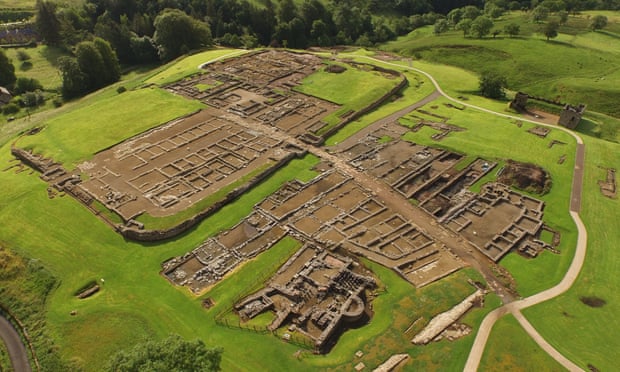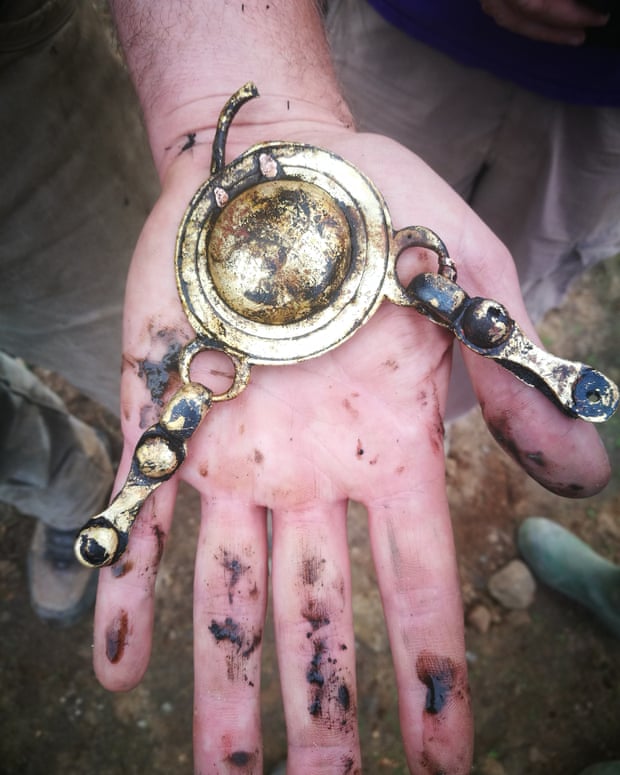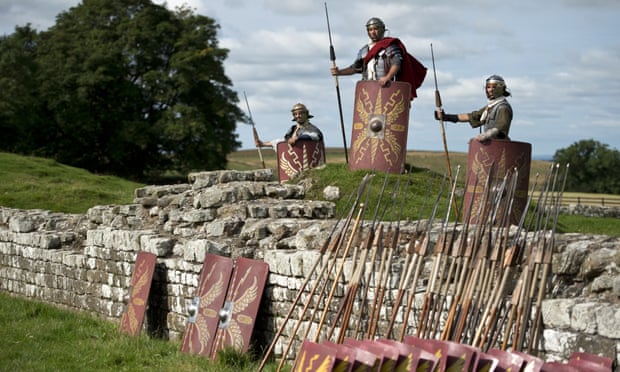Unearthed near Hadrian’s Wall: lost secrets of first Roman soldiers to fight the Picts
Dig team stumble across thousands of pristine artefacts at ancient Vindolanda garrison site in Northumberland
Archaeologists are likening the discovery to winning the lottery. A Roman cavalry barracks has been unearthed near Hadrian’s Wall, complete with extraordinary military and personal possessions left behind by soldiers and their families almost 2,000 years ago. A treasure trove of thousands of artefacts dating from the early second century has been excavated over the past fortnight.
The find is significant not just because of its size and pristine state, but also for its contribution to the history of Hadrian’s Wall, showing the military build-up that led to its construction in AD122. The barracks pre-dates the wall: the Romans already had a huge military presence in the area, keeping the local population under control.
“The native Britons took an opportunity, when the emperor Trajan died in AD117, to rebel,” says Andrew Birley, who heads the archaeological team. “The soldiers stationed in the north before the wall was built became involved in fighting and were very vulnerable. The evidence we have from this [find] shows the incredibly rich and diverse lifestyle these people had.”
Archaeologists stumbled on the site by chance and have been taken aback by finds in a remarkable state of preservation. These include two extremely rare cavalry swords – one of them complete, still with its wooden scabbard, hilt and pommel – and two wooden toy swords. One has a gemstone in its pommel.
As well as other weapons, including cavalry lances, arrowheads and ballista bolts – all left behind on the floors – there are combs, bath clogs, shoes, stylus pens, hairpins and brooches. Sections of beautifully woven cloth have also been unearthed. They may have come from garments and have yet to be tested.
There are also two wooden tablets covered in marks made in black ink. They are thought to be letters, but their contents have yet to be deciphered as they were rushed into a conservation laboratory to ensure their survival.
The barracks, which dates from AD105, was found beneath the fourth-century stone fort of Vindolanda, south of Hadrian’s Wall near Hexham, Northumberland. It is one of the site’s earliest barracks. Hadrian did not begin his 73-mile defensive barrier – to guard the north-western frontier of the province of Britain from invaders – until 122.
The artefacts survived because they were concealed beneath a concrete floor laid by the Romans about 30 years after the barracks was abandoned, shortly before 120. The concrete created oxygen-free conditions that helped preserve materials such as wood, leather and textiles, which would otherwise have rotted away.
Birley said: “The swords are the icing on the cake for what is a truly remarkable discovery of one of the most comprehensive and important collections from the intimate lives of people living on the edge of the Roman Empire at a time of rebellion and war. What’s exciting is that [they] are remarkably well-preserved … There is a huge range of stuff – their hair combs, pots, wooden spoons, bowls, weapons, bits of armour, and their cavalry bling.
“Even for us, it’s very unusual to get things like complete Roman swords, sitting on the ground in their scabbards with their handles and their pommels. We were slightly dumbfounded by that. Then, to find another complete sword in another room next door only two metres away, two wooden swords and a host of other cavalry equipment, all in beautiful condition, is just terrific.
“Archaeologists would never expect to find a Roman cavalry sword in any context, because it’s like a modern-day soldier leaving his barracks and dumping his rifle on the floor … This is a very expensive thing. So why leave [it] behind?”
He recalled feeling “quite emotional” over the discovery: “You can work as an archaeologist your entire life on Roman military sites and never expect, or imagine, seeing such a rare thing, even at Vindolanda. It felt like the team winning a form of archaeological lottery, and we knew we had something very rare and special before us.”
Archaeologists lifted up a piece of concrete flooring while exploring the foundations of the fourth-century stone fortress. They were struck by a layer of black, sweet-smelling and perfectly preserved anaerobic soil in an area where it was completely unexpected.
Hidden in this soil, they went on to find, were the timber walls and floors, fences, pots and animal bones from the abandoned barracks. To their astonishment, excavating about 3.5 metres down, they uncovered eight rooms, with stables for horses, and living accommodation, with ovens and fireplaces.
They believe that the base was home to more than 1,000 soldiers and probably many thousands more dependants, including slaves. The Romans had covered over this early barracks with concrete and heavy clay foundations before building another above it. At Vindolanda, garrisons would arrive, build their forts and destroy them when leaving.
Birley said: “We have got successive barracks above them, some of which are also cavalry, but they’re much later and not preserved with anything like the range of material that has come from within the anaerobic conditions. What you’re seeing here is the full range of stuff, and all those little details that normally rot away completely.”
Cavalry swords are very rare, even across the north-west provinces of the Roman empire, he said, partly because they are so thin. “They’re very light, a couple of feet long, designed to slash somebody as you’re riding past, with a wickedly sharp blade and a point.”
Other finds include copper alloy cavalry fitments for saddles, strap junctions and harnesses. They are in such fine condition that they still shine and are almost completely free of corrosion. The strap junctions are preserved so beautifully, he said, that they have all their alloy links – incredibly rare survivals.
Much of the pottery has graffiti, from which the archaeologists hope to work out the names and stories of some of the people who lived here.
The discovery is all the more emotional for Birley, as his archaeologist father, Robin, headed the team that discovered the famous Vindolanda writing tablets in 1973. The new tablets may give further insights. They are letters either sent to, or written by, the people living in those buildings.
Birley said: “So, as a collection of stuff, it doesn’t really get better than that. Some of the documents will hopefully give the names, the characters, what they’re thinking about, what they’re doing.”
Quite why so much valuable material was left behind has yet to be discovered. One theory is that the barracks was abandoned in a hurry. Birley said: “There was strife. This is the precursor to Hadrian coming to the UK to build his wall. This is the British rebellion. So you can imagine a scenario where the guys and girls at Vindolanda are told: ‘We need to leave in a hurry, just take what you can carry.’ If it’s your sword or your child, you grab the child.”




No comments:
Post a Comment